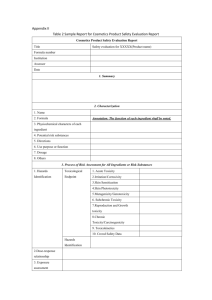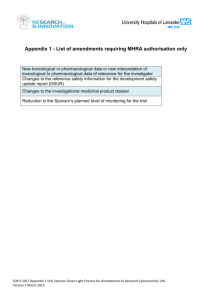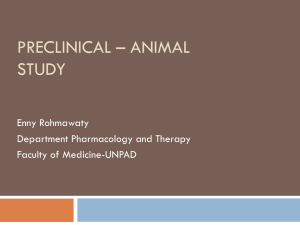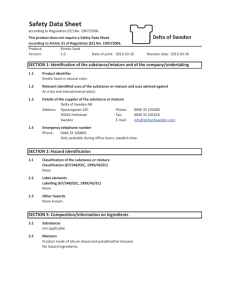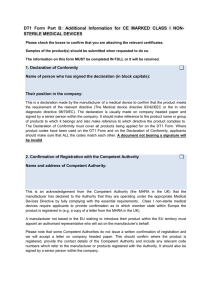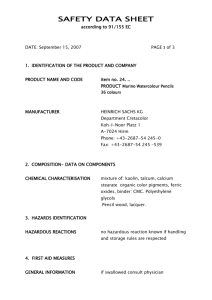5 GUIDANCE ON THE BIOLOGICAL SAFETY
advertisement
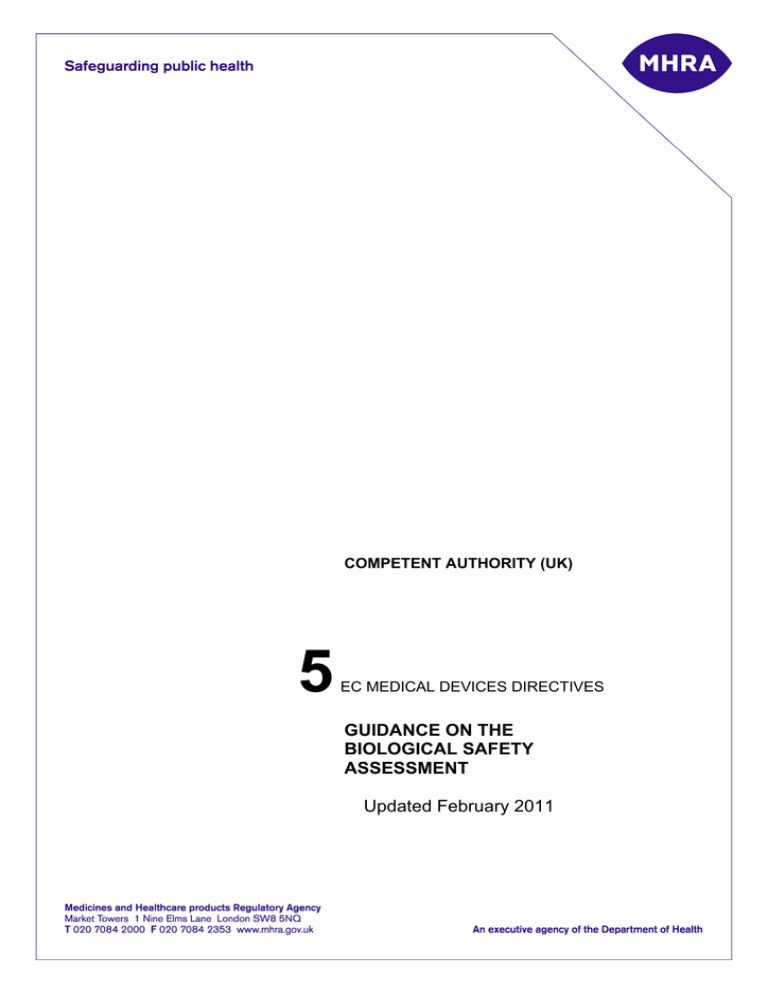
COMPETENT AUTHORITY (UK) 5 EC MEDICAL DEVICES DIRECTIVES GUIDANCE ON THE BIOLOGICAL SAFETY ASSESSMENT Updated February 2011 CONTENTS PAGE Introduction 2 Conformity Assessment Requirements 2 UK Competent Authority Requirements 9 Further Information 9 In line with the requirements of the Hampton Report on Reducing Administrative Burdens Effective Inspections and Enforcement, MHRA keeps its guidance documents under constant review. If you have any feedback, particularly on the presentation, accessibility or clarity of any of our guidance notes or bulletins please inform the contact person indicated at the end of the individual document. 2 INTRODUCTION An assessment of toxicological risks is necessary for the assurance of biological safety. (Other biological risks, such as microbial contamination, are excluded from this type of assessment.) It is evident from Annex VIII of the Medical Devices Directive that a biological safety evaluation needs to be carried out before any clinical investigation is commenced. This is on the one hand to provide an acceptable level of reassurance to the patients in a clinical investigation and on the other hand because biological safety is an aspect of conformity assessment that will never, in its entirety, be investigated by the proposed clinical study. The manufacturer of a device is responsible for documenting the results of the biological safety analysis and for establishing the effectiveness of the analysis (Annex VIII, Section 3.2 of the Medical Devices Directive). In assessing a notification, the Competent Authority must be able to verify that an appropriate toxicological risk assessment has been carried out so that it can ensure that public health is not endangered (Article 15, (6) of the Medical Devices Directive). The data requirements for a Competent Authority verification may differ considerably from those for the toxicological assessment itself. This is because the final responsibility for the safety of the product remains with the manufacturer. The UK Competent Authority only requires sufficient data to indicate that the nature, scope and result of the manufacturer’s assessment are adequate. In many cases, an informative statement by the manufacturer’s assessor, which demonstrates that the appropriate toxicological risks have been investigated and found to be acceptable when weighed against the intended performance, can suffice This Guidance Note sets out the information that the UK Competent Authority expects to see with a clinical investigation submission in order to verify that the requirements of the relevant European Directive have been met. As a precursor to this, guidance is provided for manufacturers on the scientific basis, conduct and documentation of their own biological safety evaluations carried out for conformity assessment purposes. 3 CONFORMITY ASSESSMENT REQUIREMENTS Several of the Essential Requirements in the Medical Devices Directive and the Active Implantable Medical Devices Directive refer to, or also apply to, the biological safety of the device. They describe which aspects should be taken into account in the design and manufacture of a medical device. The main safety aim is that the device will not compromise the clinical condition or safety of the patient or user or other persons, “provided that any risks which may be associated with their use constitute acceptable risks when weighed against the benefits to the patient...". To be able to determine what are acceptable risks, qualified personnel are needed to perform a state of the art risk benefit analysis. If such expertise is not present within the company, external advice from suitably qualified sources should be sought. The Essential Requirements provide some detail as to what aspects of biological safety should be considered, namely 1. the choice of materials used as regards toxicity (Requirement 7.1) 2. the compatibility between the materials used and biological tissues, cells and body fluids, taking account of the intended purpose of the device” (also Requirement 7.1) 3. minimisation of risk from contaminants and residuals, where particular attention must be paid to the tissues exposed and the duration and frequency of exposure (Requirement 7.2). The concept minimisation rather than acceptable risk is used here because residuals and contaminants are expected to only bring risk and no benefits 4. safe use of the device with the substances they will enter into contact with during their normal use (Requirement 7.3) 5. risks from substances leaking from the device must be minimised (Requirement 7.5) 6. risks from unintentional ingress from substances into the device must be minimised (Requirement 7.6) 7. risks from ageing of the materials used in situations where the device cannot be maintained or calibrated (such as implants) should be minimised (Requirement 9.2). From a toxicity point of view, this means that breakdown products of the materials used should be taken into account in the risk assessment of long-term devices. TOXICOLOGICAL RISK ASSESSMENT There is thus a need for a biological risk assessment of the device. This assessment should include consideration of all toxic endpoints. Biological safety cannot be demonstrated adequately using a “check-list” approach. A systematic analysis of biological risks is required. Attention is drawn to the general principles 4 applying to the biological evaluation of materials and devices set out in Clause 3 of EN/ISO 10993-1. Unfortunately, the matrix in EN/ISO 10993-1 is often used as a checklist to perform a standard set of tests. What is actually needed is a qualified individual developing an evaluation programme based on the specifics of the device. It might well be that data is already available from other sources that allow evaluation of the hazard without the need for further tests. It should be kept in mind that individual considerations of the device might lead to a need to assess toxic end points over and above the ones listed in the table. Such “individual considerations” include, but are not limited to, the site of exposure of the device and the duration of exposure. For example regarding exposure duration, longterm exposure can be obtained via a single device application (e.g. implants), or via repeated use of new single use devices (e.g. contact lenses, colostomy bags). In the first case, the effects of degradation products need to be assessed in addition to the exposure to the device materials. In the second case, long-term exposure to the device materials still needs to be assessed, but individual device exposure might be short enough that the exposure to breakdown products could be negligible. The guidance on the specific tests in different parts of EN/ISO 10993 only discusses the test and sample methods, it does not specify pass/fail criteria. It is not possible to comply with the Essential Requirements by listing the tests done according to 10993 and indicating a "pass" behind each test. The results of the tests should be interpreted in the context of the overall risk assessment to know whether a specific outcome indicates acceptable risk or not. This once again emphasises the need for an overall, scientifically valid risk assessment. The three basic types of information required for a toxicological risk assessment are identified in Annex C of EN/ISO 14971, i.e. • the chemical nature of the materials (including the toxicity of ingredients); • prior use of the materials; and • biological safety test data. Toxicological hazard is a property of the chemical constituents of the materials from which a medical device is made and should be considered in relation to the hazard identification steps of EN/ISO 14971 (Steps 1 and 2). The latter two types of data listed above are dependent upon exposure to a particular material or device and thus predominantly address the risk of an adverse reaction occurring, rather than hazard. 5 HAZARD IDENTIFICATION The toxicity of a compound or material is investigated using basic toxicology studies which provide information on the nature of toxic effects elicited by a test material, the dosages at which the effects occur and the no-effect levels. There is a widespread misconception that ‘medical grade’ materials (or “surgical grade” or “implant grade”) exist. In the EU there is no regulation or standard that defines what a medical grade material would be and indeed, considerations to achieve acceptability for implantation in an orthopaedic implant would be quite different for a vascular stent. Compliance of a material with a Pharmacopoeial requirement does confer some reassurance insofar as that is a well-recognised starting point. EN/ISO 14971 requires that relevant characteristics that could affect safety are listed and, from these, possible hazards are identified. For a biological safety assessment, the first step comprises characterisation of materials. Data relating to formulations, additives, processing aids, degradation products, effects of processing, residue levels, etc. allow the chemical nature of the material(s) to be fully characterised. Toxicological hazards can be identified from a knowledge of the toxicity of the chemicals or materials listed. RISK EVALUATION The probability that an adverse effect will arise from exposure to a chemical depends not only on its inherent toxicity, but also on the amount to which a subject is exposed and the route of exposure. This means that information on the identity and toxicity of materials, residues, degradation products, etc. must be considered in relation to quantitative data on the amount present in the final product, its leachability and systemic availability. This analysis is analogous to the requirements of Clause 4.4 of EN/ISO 14971. In practice this means that in many cases an exposure assessment will already provide sufficient justification for limiting the number of toxic end points that need to be addressed in more detail. Where significant risks arising from hazardous residues are identified by this procedure, their acceptability should be assessed in line with established toxicological principles. Additional information from biocompatibility tests or prior use of materials may be used to provide a basis for further assessment of risks. As regards prior use data, once again the site and duration of exposure of the new device compared to the prior use should be kept in mind. These data provide either an estimate of risk in line with Clause 4.4 of EN/ISO 14971 or a measure of the acceptability of risks in line with Clause 4.5, respectively. 6 Acceptable results from appropriate biological tests, of the sort described in the EN/ISO 10993 series of standards, may give a degree of reassurance that the risk of adverse reactions occurring during clinical use is low. EN/ISO 10993-1 indicates evaluation tests which can form a framework for the development of an assessment programme. These tests, commonly termed biocompatibility tests, differ from basic toxicity tests in that they typically attempt to mimic the conditions of clinical exposure to medical devices and thus provide an indication of the probability of adverse effects arising during use. They tend, as a result, to be less sensitive than basic toxicity tests and are thus a less discriminating indicator of risk. Biocompatibility test data should therefore be used to complement an assessment based on materials characterisation, rather than as a replacement for it. It may not be necessary to perform tests suggested by the standard in all cases. Where the proposed materials have already been extensively used or tested, little or no biological testing may be necessary to judge the biological safety of the device. Conversely, the need for additional tests such as mutagenicity or metabolism studies should be considered on a case by case basis. National laws may prohibit unnecessary animal tests and the need for testing should always be judged in relation to the predictive value of the test and animal welfare considerations. Well established and documented clinical use of materials or their chemical components in an analogous situation can provide an indication of their suitability for an intended purpose. Risks anticipated from the intended use are assumed to be similar to those known, through clinical experience, to be acceptable in a comparable situation. It is common practice to evaluate biological safety primarily on the basis that the materials have been used before in similar applications. This sort of evaluation requires sufficient knowledge of the chemical identity of the material or chemical to determine equivalence. It also requires clinical evidence to demonstrate that the material or chemical has performed with a suitable biological response. This may be in the form of the results of a clinical investigation or data relating to previous commercial use and adverse incidents. It will be clear that the absence of adverse effects in commercial use without some feedback mechanism to identify potential problems is of very limited value. It should be noted that for chronic toxic endpoints, such as mutagenicity, this approach generally provides less reassurance as it is unlikely that enough accurate epidemiological data are available to link adverse effects with a long incubation period (such as cancer) with the use of certain products. As mentioned before, differences in sites and durations of exposure should be taken into account and might significantly reduce the usefulness of the prior use data. It is important to recognise that, even where an assessment is based entirely on previous clinical experience, the biological safety evaluation needs to be documented by the manufacturer and that such an evaluation is just as much in line with the principles set out in EN/ISO 10993-1 as one that incorporates biological testing. 7 DOCUMENTATION OF A BIOLOGICAL SAFETY ASSESSMENT Sufficient pre-clinical data must be documented by the manufacturer to demonstrate how the biological safety of the device was assessed. The amount and nature of data necessary for an assessment varies with the intended nature and duration of patient contact and with the nature of the data that is readily available. It is not possible to identify precisely what information may be needed in any given instance since deficiencies in one area may be compensated for by data of another type. In general, biological safety data should be assessed in respect of all components with tissue, blood, mucous membrane or fluid path contact. Documentation of an evaluation for the purposes of a manufacturer’s conformity assessment should normally include or reference the following: 1 .A GENERAL DESCRIPTION OR DRAWING OF THE DEVICE For each component, the generic (e.g. PVC) and trade names of the material(s) used, the producer of the material, the nature of patient contact (e.g. blood, fluid, topical, non-contact, etc.) and duration of proposed use should be stated. 2 .QUANTITATIVE FORMULATIONS FOR ALL MATERIALS IN CONTACT WITH TISSUES OR INFUSABLE FLUID This should comprise the chemical names and concentrations of all ingredients, including additives, processing aids, catalysts, etc. Where the presence in the final product of biologically active ingredients or reaction products is possible, the need for information on residue concentration should be considered. Where exposure to the device will be long-term, the potential for in situ degradation and the identity of the potential degradation products should be considered. Where formulation data, or any other information relevant to the submission, are not available to a manufacturer, arrangements should be made for the supplier to make these available to the assessor on a confidential basis. Where data are excluded from the documentation due to confidentiality, their source and general nature should be noted. 3 .A REVIEW OF AVAILABLE TOXICITY AND PRIOR USE DATA FOR EACH MATERIAL AND CHEMICAL IN CONTACT WITH TISSUES OR INFUSABLE FLUID This should include, where appropriate, data on residual monomers, contaminants, additives, catalysts, mould release agents, sterilisation agents and other processing chemicals and degradation products, where applicable. Data should be sufficient either to characterise the toxicity of the material or to indicate that it can be considered suitable for the proposed use. Where significant residues of biologically active ingredients are present, the need for data on their migration, leaching or 8 absorption should be considered. Toxicity information may not be necessary for materials or chemicals which have been widely used in medical devices with similar exposure conditions and a documented history of absence of adverse effects. Justification for such omissions should be given. 4 .INFORMATION ON PREVIOUS EXPERIENCE WITH EACH MATERIAL IN RELATED APPLICATIONS Where available, a summary of experience from clinical use of the materials should be documented. This should include details of the nature of patient contact, the number of devices used, the period of time for which they have been used and the number and nature of adverse reactions. For novel materials, this information may be necessary for each ingredient. Where the mode of patient contact or the chemical or physical nature of the established material is not identical to that in the intended application, the differences should be identified and an assessment of their significance documented. Where relevant, the results of clinical investigations which address biological safety should be included. 5. REPORTS OF BIOLOGICAL SAFETY TESTS The full reports of biological safety tests carried out on the device as a whole or on component materials should be available. A scientific justification for the performance of each test, or the omission of any test suggested by EN/ISO 10993-1, should be documented 6. AN ASSESSMENT OF THE DATA REVIEWED The documentation should include an appraisal of the toxicological significance of the data, by someone with experience in the assessment of the biological safety of medical devices. Suitability of the materials for the intended use should be judged on the basis that there is sufficient information to provide a realistic level of assurance that the risk/benefit ratio is acceptable or toxicological risks are no greater than those currently deemed acceptable for existing devices. UK COMPETENT AUTHORITY REQUIREMENTS The manufacturer of a medical device is responsible for assuring its biological safety and for documenting the assessment of toxicological risks, in line with the Essential Requirements of the relevant European Directive. The UK Competent Authority normally expects manufacturers to provide evidence that biological safety has been appropriately assessed for notifications of devices involving novel materials or novel uses of known materials. For such notifications, sufficient details should be provided to demonstrate that an assessment equivalent to that outlined above has been 9 carried out by an appropriately experienced assessor with access to sufficient relevant data. This should normally include a summary of the data assessed and the basis for the assessor’s appraisal and judgement, in line with paragraph 6 above. There are two circumstances under which the UK Competent Authority will request further details of biological safety data. Namely: • for audit purposes, it may request specific data to verify particular aspects of a safety assessment; • where doubts remain that a satisfactory biological safety assessment has been carried out, sufficient data may be requested to enable its expert assessors to determine conformity with relevant Essential Requirements for themselves. FURTHER INFORMATION Enquiries regarding this document or the clinical investigation procedure should be addressed to: Mrs Daniella Smolenska European and Regulatory Affairs Medicines & Healthcare products Regulatory Agency, 5 Magenta 151 Buckingham Palace Road Victoria London SW1W 9SZ Tel: 020 3080 7363 Email: Daniella.smolenska@mhra.gsi.gov.uk Or MHRA, European Regulatory Affairs E-mail address: era@mhra.gis.gov.uk Internet address: www.mhra.gov.uk 10

